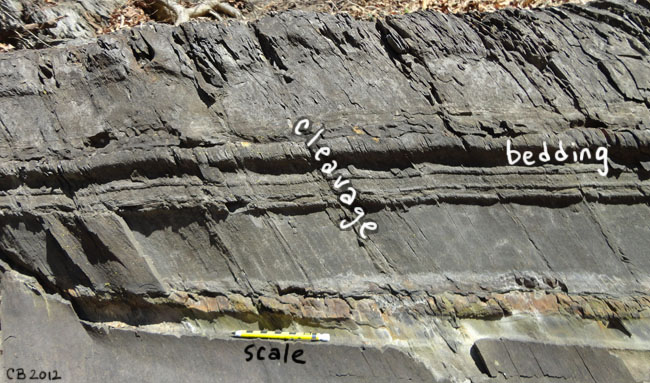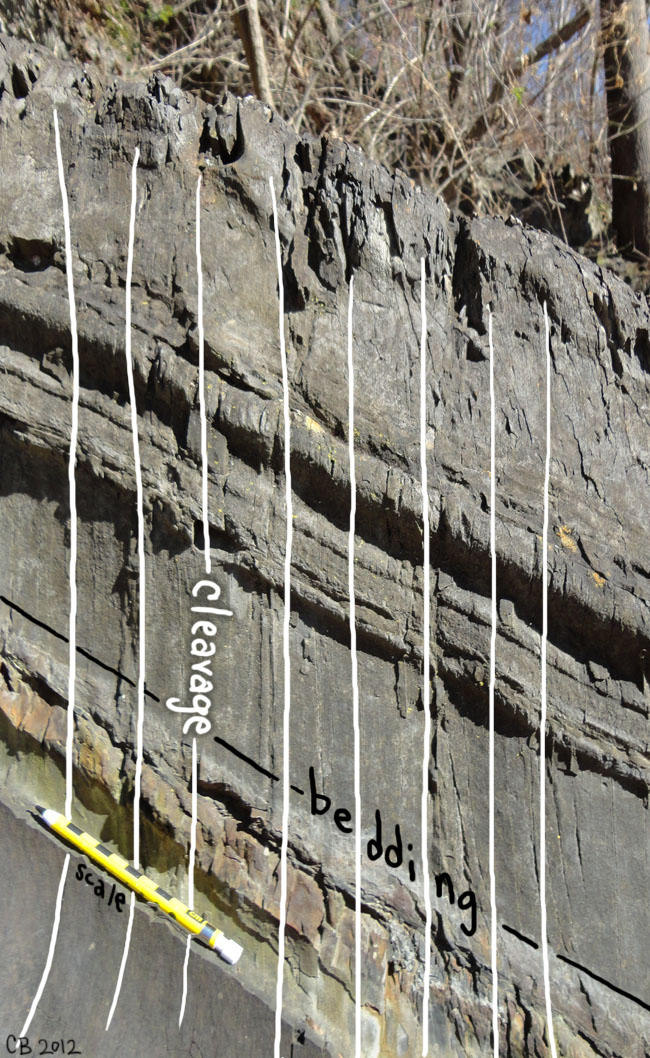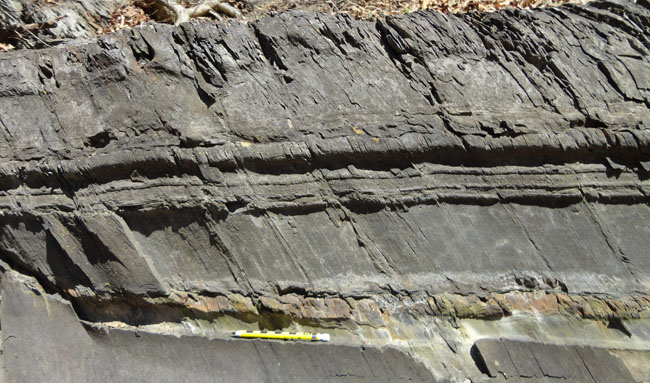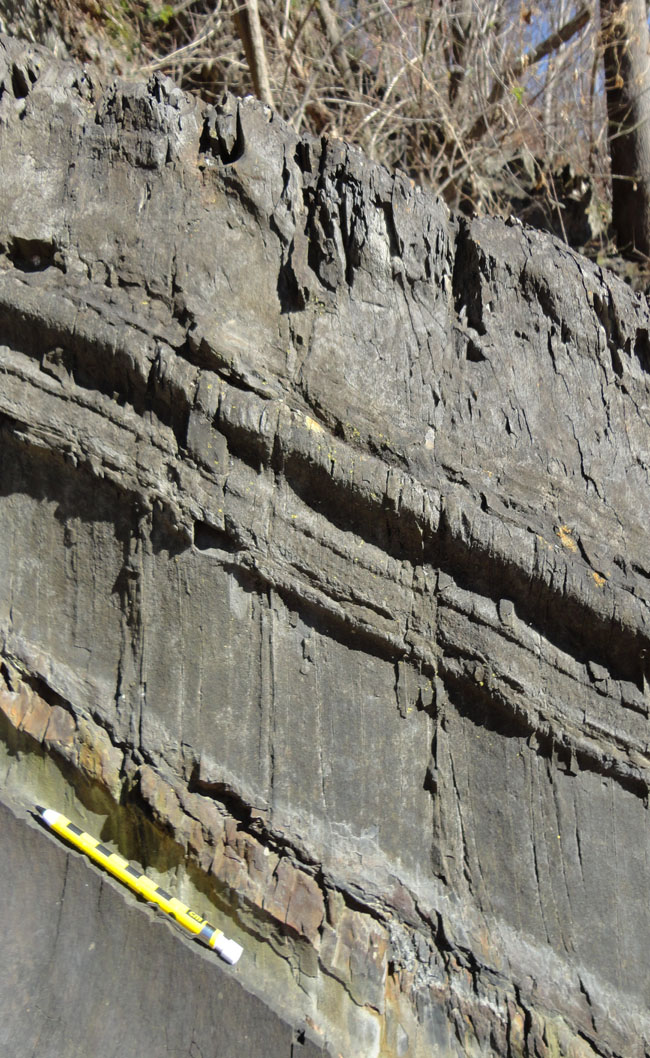21 November 2012
Rock Cycle I: Sedimentary → Metamorphic
Posted by Callan Bentley
This past Saturday, I was out on a geology-tour-for-hire field trip with a local citizen who contracted me for the day. We basically ran through my Massanutten Synclinorium trip that I bring NOVA students on. The lighting was really good that day, and though I’ve featured a photo of this outcrop previously, I couldn’t resist re-shooting it on Saturday. I wanted to showcase it again as a superb example of a rock unit transitioning from sedimentary to metamorphic.
Here it is, with the photo’s horizontal edges aligned parallel to bedding:
This is the Martinsburg Formation, a late Ordovician turbidite/shale unit that lies stratigraphically between the Sauk/Tippecanoe epeiric carbonates and the Silurian-aged Massanutten Sandstone. It’s Taconian flysch, which is to say “dirty” orogenic sediment derived from the first phase of Appalachian mountain-building, the Taconian (“Taconic”) Orogeny, which was basically the accretion of a volcanic island arc with the eastern margin of the ancestral North American continent (a.k.a. Laurentia). This outcrop features graded bedding and cross-bedding as Bouma sequence treats.
The Martinsburg and every other stratum in the Valley & Ridge province was deformed during the Alleghanian Orogeny, the final phase of Appalachian mountain-building. It occurred in the late Paleozoic (Pennsylvanian into Permian), due to Gondwana (with northwest Africa as its leading edge) smacking into the eastern seaboard of ancestral North America. During this time, the strata of the easternmost Valley & Ridge province were warped into a massive downturned fold, the Massanutten Synclinorium. The perspective of these photos is looking north-northeast (along strike) on the western limb of that synclinorium, so the bedding dips to the east-southeast. The clay minerals that dominated the Martinsburg reacted and formed very fine grained sericite and chlorite according to this report (I wouldn’t be surprised if there was some fine-grained muscovite in there, too). These are new minerals that are the consequence of low-grade metamorphism.
In this rendition, the photo’s vertical edges are aligned with the cleavage that is defined by the alignment of the fine-grained platy minerals:
You can enlarge both of those images by clicking on them.
Here are annotated versions:


This, in my mind, is 100% beautiful – a classic example of the rock cycle caught “red-handed” – one rock (shale) transforming into another (slate). I’m not the only one who thinks so, either. In the new edition of Earth by Tarbuck, Lutgens, & Tasa (to be published in January), you’ll see a photo of this same outcrop used to illustrate the concept of the inception of slaty cleavage.
There’s been some discussion in the geoblogosphere over the past couple of days about the rock cycle, precipitated by Andrew Alden’s attempt at building a better Rock Cycle diagram. I’d like to take the opportunity of putting up three posts in the next week that examine rocks “on the cusp” between one category and another. Let’s call the series Transitions of the Rock Cycle. This is the first installment. Next up, we’ll take a look at a metamorphic rock transforming into magma (on its way to becoming an igneous rock), and an igneous rock transforming into sediment (on its way to becoming a sedimentary rock).




 Callan Bentley is Associate Professor of Geology at Piedmont Virginia Community College in Charlottesville, Virginia. He is a Fellow of the Geological Society of America. For his work on this blog, the National Association of Geoscience Teachers recognized him with the James Shea Award. He has also won the Outstanding Faculty Award from the State Council on Higher Education in Virginia, and the Biggs Award for Excellence in Geoscience Teaching from the Geoscience Education Division of the Geological Society of America. In previous years, Callan served as a contributing editor at EARTH magazine, President of the Geological Society of Washington and President the Geo2YC division of NAGT.
Callan Bentley is Associate Professor of Geology at Piedmont Virginia Community College in Charlottesville, Virginia. He is a Fellow of the Geological Society of America. For his work on this blog, the National Association of Geoscience Teachers recognized him with the James Shea Award. He has also won the Outstanding Faculty Award from the State Council on Higher Education in Virginia, and the Biggs Award for Excellence in Geoscience Teaching from the Geoscience Education Division of the Geological Society of America. In previous years, Callan served as a contributing editor at EARTH magazine, President of the Geological Society of Washington and President the Geo2YC division of NAGT.
This is a really neat idea! I’m excited for the future installments.